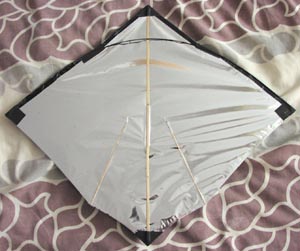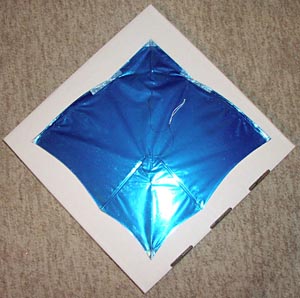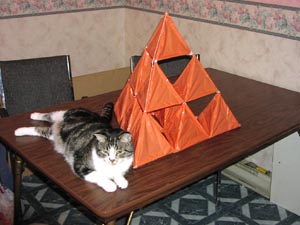 |
The renewed kite building obsession started with a Bell Tetrahedral found on a web page. Made from 60 drinking straws and a couple of garbage bags. It flew well but was a little fragile.
Jessie the cat (one of 3 resident animals) adopts his usual position. If kites are on the table then he has to be there too! One of these days he WILL get sewn into a kite! |
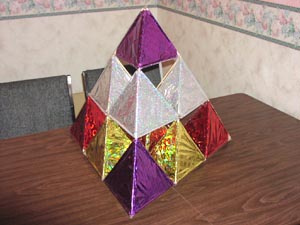 |
From straws and garbage bags we moved to wood dowel and mylar gift wrap. The kite looked wonderful when the sun caught the holographic material but unfortunately the sail to lift ratio was way off and it required a gale to get it into the air!
Tip #1 - Build light! |
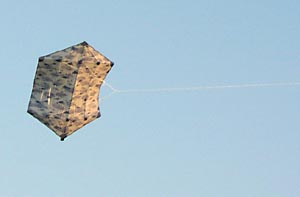 |
Our next project was a Rok after seeing how well Rick's Roks flew in very low winds. Materials used were fibreglass tent poles, wood dowels and a shower curtain! It flew well considering the materials but was prone to excessive sail stretch which would eventually cause it to gently drop out of the sky. |
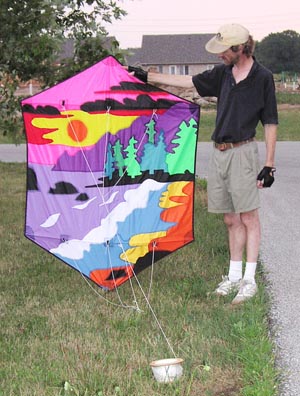 |
Rick took pity on us and gave us several shopping bags stuffed full of his scrap ripstop pieces (thanks Rick). After playing around with designs on the computer we finally settled on the 'Beach Rok' design. It took four, twelve hour, days to sew the pieces together! The spars were taken from the 'Bathroom Rok' and it flew very well.
Tip #2 - Using better materials gives better results! |
 |
The 'Beach Rok' on it's maiden flight. It really is a joy to watch it in the sky and you can almost 'see' the waves crashing onto the beach.
This kite provided my first experience of 'AoxomoxoA', a truly wonderful feeling! |
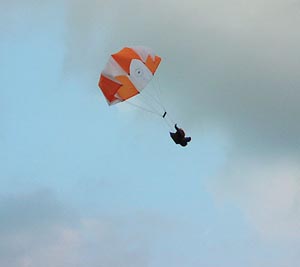 |
Building and flying kites is fun but how can you increase the amount of fun?
PARABEARS! We soon got hooked on this crazy fun, soft toys equipped with backpacks and parachutes that are dropped from kites. We now have several different sizes and a selection of methods for launching them. |
 |
Our first method was a 'messenger' system that carried the bear up to a stop on the line. When the messenger hit the stop the bear is released and a ripcord pulls the chute out of the backpack. This works well for days with a good ground wind and small bears but conditions have to be just right for successful drops. |
 |
This is our 'Big Guy' and weighs in at almost 3 lbs. He is too heavy to 'ride' the messenger so we used a static line release for him. This worked well but the 'extra' line can get tangled on the bear causing tangles or premature release and the kite needs to be pulled part way down in order to reload the bear.
I have since developed a pulley dropper system where a pair of pulleys are fixed to the flying line and the bear is hauled into the air and remotely released when it reaches the flying line. This has two distinct advantages, the release line no longer gets tangled in the bear and the kite does not have to be hauled down to reload the bear. The plans for the pulley dropper are elsewhere on this site (see the 'Plans' link on the left or click this link to go there directly). |
 |
The building bug was still biting hard but by now all we had left was a single strip of black and a lot of very small pieces of ripstop. The answer was to build a 'jig-saw' NPW5. The jig-saw pieces are all less than a foot square and were all individually sewn together.
This was our first attempt at a multi-line kite and our first 'power' kite. |
 |
Rick supplied us with some more ripstop scraps and this time we decided to build a Delta Conyne.
The plans were found on the web and this kite will fly in everything from a slight breeze to heavy winds. I later added a pair of tube tails to stop it's tendency to over fly the zenith. |
 |
While searching the web for plans I came across the 'Megue'. This is a quad-line sport kite and was my first foray into the field. It flew ok in medium winds but was a bit 'twitchy' and slow ('Megue' actually translates as 'slow' so that is perhaps why!) |
 |
I do love unusual kites and this one is certainly unusual. The 'UFO' is a spinning kite made from carbon fibre, fibreglass and mylar. It breaks all the laws of aerodynamics but it certainly flies and the spin rate increases with wind speed. When the sun catches the silver mylar it sends blinding flashes across the field and can be seen from several miles away! |
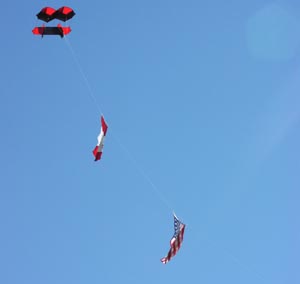 |
By now we were getting a reputation in the Club as skilled kite builders and Rick asked if we could build him a kite. We were more than happy to do this as he had supplied all the ripstop scraps that got us started down this wonderful kite building road. The kite of choice was a Compound Cody with plans from the web again. The spars are all wooden dowels and this kite flies very well and will lift a heavy payload of line laundry and flags. |
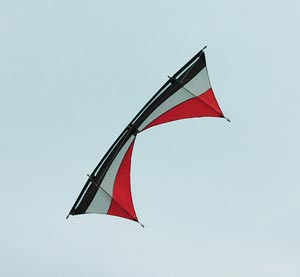 |
After flying the 'Megue' I was hooked on quad-lines but wanted something with a little better performance. Yet another web search (gotta love the internet!) came up with plans for the 'Freedom 2000'. This is a 'Rev' look-a-like and flies very well. I 'salvaged' the spars from the 'Megue' and the sail material was provided by Rick again. The 'Freedom' designer, Jean-Pierre Gleyzes, put a photo on his site and honoured us by calling it the best looking 'Freedom' he had ever seen! |
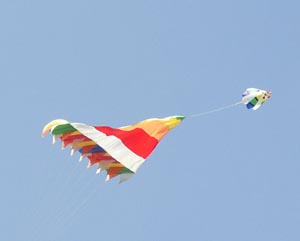 |
We were very honoured when Adrian Conn gave us the second parafoil he ever built (50 sq. ft.). Adrian is a master kite builder (former AKA multiple champion) and a fellow Club member. We treasure this kite as it is very special and still flies like a dream despite being over twenty years old. Adrian has taken us under his 'wing' and it is a standing joke within the Club that we are his 'proteges'! With a mentor like Adrian we are more than happy to be 'proteges'.....;-) |
 |
Christmas 2002 was fast approaching and Rick asked if we could build him a couple of identical NPW5's. One was for him and the other was going to his step-son as a Christmas present. The material was a light weight nylon found in the remnants bin at Wal-Mart! It is slightly porous but for a 5M2 NPW this is not a bad thing! |
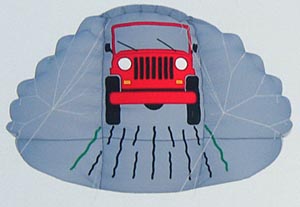 |
Hard on the heels of the previous two NPW's Rick asked us to build another one for his son's birthday in early January. As Craig is a 'Jeep-nut' there was only one choice for a design. The Jeep is all appliqued to the sail and this time it is a 5M2 made entirely from ripstop nylon and it pulls like a truck! Craig even used it to go kite snow boarding! |
 |
Late in the fall of 2002 my Mother called me from England to tell me she had 'discovered' an old Readers Digest book in the attic that had kite plans in it. I asked her to photocopy the plans for the parafoil I built many years ago and post them to me. On Boxing Day 2002 I was bored and Karen and I decided to re-create the first foil I ever built more than 30 years ago! It flies just as well as the original and it was this kite that got me hooked on kites in the first place. |

|
Early in January 2003 I was approached by NPW Bill to see if I was interested in helping him with a brand new design of NPW power kite he was developing. He lives in Phoenix, AZ and suffers from a lack of wind and asked myself and Tom White in Winnipeg, MB if we could help to 'tune' the sail for the best performance. Tom and I jumped at the chance and the three of us formed a development team that was to grow to over a dozen members in nearly as many countries. I had the honour of building and flying only the second NPW9b to exist anywhere in the world and what an experience it was. If flying a NPW5 was like flying a pick-up truck then flying a NPW9b was like flying a locomotive....the pull was absolutely amazing for a kite that is only 2.8M2 in area. Tom and I were working in temperatures well below freezing and on one occasion I ended up with mild frost bite on my finger tips after trying to adjust bridle lengths in the field during a snow storm! |
 |
NPW Bill had sent me a graphic design he had been playing with for use on his NPW's. I reworked the design using his basic ideas and once all the tuning was done on the NPW9b prototype we turned the graphic into the 'NPW9b Vulture' with a sail size of 2.8 M2. This particular 'Vulture' is well travelled as I sent the kite to Tom White in Winnipeg and he took it on vacation with him to Jasper National Park where this photo was taken. On his return home the kite was sold to a visiting Brit and the kite now flies in the skies of southern England. It has probably 'clocked' more air-miles than most of our local turkey vultures! |
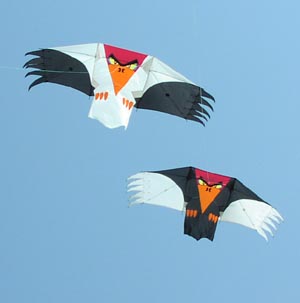 |
The 'Vulture' design sparked an idea for a range of kites all using the same central panel but with different wing panels depending on the type of kite required. The first kites in the new 'Vulture Family' were a modified Genki style with 'fluttering' wing tip feathers and a very life-like moving tail. These 'Vultures' are superb fliers and will fly in almost zero winds and will ride thermals like a real bird during those long, hot, summer days. I have had them sitting 40 feet UPWIND of me with a totally slack line and they just floated there until a puff of wind sent them drifting downwind again. Another 'AxomoxoA' moment! |
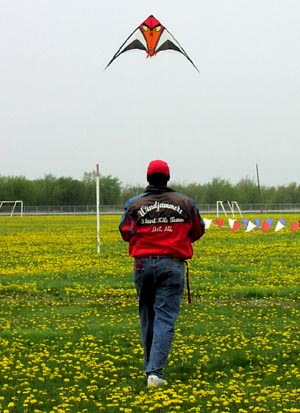 |
The third kite in the 'Vulture Family' was an 8.5 ft. wingspan sport kite. This kite was designed as a precision/ballet kite and it's tracking and turning abilities are spot on. It will even do a range of basic tricks. I had finished it just in time for our Make-A-Wish® Festival in May 2003 and asked Gary and Mike of the Windjammers stunt kite team to evaluate it's performance. They both put it through it's paces and amazed me with just what the kite was capable of in the right hands! By the time they were through they both had huge ear-to-ear grins and were very complimentary of the kite and it's performance. |
 |
This is a 2M2 NPW9b we built for our daughter Alex's 10th birthday. She drew the design on a piece of paper, Karen redrew it on the computer and then I converted it to a CAD file so that I could print out the templates. The design is all appliqued into the main sail. It is hard to see in this shot but the tongue is a separate piece sewn into the mouth and it 'wags' as the kite flies! The dog tag bears the name "Pinky"! |
 |
In August 2003 Adrian Conn gave us another of his very beautiful parafoils (80 sq. ft. this time). This time it was an old experimental 'closed cell' kite of his that needed some fine tuning to make it fly better. Following his advice we added extra 'intake' ports on every other cell to aid with the inflation/deflation and changed the bridle from a static type to a 'floating' type. The changes made a huge difference to the performance and it is now a wonderful flier. |
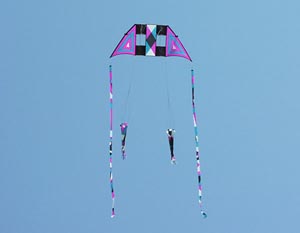
|
We were very honoured when an email friend sent us a 'care package' of four rolls of material after he learned of my disability (I am disabled and can no longer earn a living at a regular job although I could work from home if I could find the right sort of work...any employers out there need a graphic designer/technical illustrator/technical writer/web designer/kite builder!) Thanks very much for your kind gift Merwin!
The puppy above was the first kite we built from this new material and this is the second. It is a variation on my original Delta Conyne and has an additional box section and central panel making it a Double Delta Conyne. This flies like a dream and the matching spinning drogues and ribbon tails really set it off. Rather than waste valuable material making the tails I sewed all the scraps left over into a huge 'crazy quilt' and then cut that into strips to make the tails. The effect is quite stunning with the regular, geometric, shapes in the kite and the totally random shapes in the tails! This is also the first kite where I (Larry) did all the sewing (except for a little bit of help from Karen on the final seams of the boxes!) |

|
My dear e-friend NPW Bill was having a clear out of his shed and needed to get rid of a bunch of 'suit lining' material he acquired for the huge sum of $0.25 USD a yard! He had a friend coming this way from Arizona and he dropped off several bolt ends of cloth and some very large spar material. We are deeply indebted to all these friends who 'gift' us with cloth/spars as we could not afford to build all these kites otherwise. I had been 'yearning' to build a Cody for a long time and this seemed the perfect opportunity as 2003 was the centenary of Cody's patent on the 'War Kite' and the 90th anniversary of his death. There is a lot of information on the Cody War Kite on the web but very few workable plans. I based mine on one of the original plan views and calculated all the other dimensions from there. It flies well but does prefer a steady wind to fly in rather than a swirling one. We were very pleased to hear Adrian Conn remark that it was the best Cody he had ever seen! High praise indeed from a master kite builder and I did all the sewing except for the final box seams on this one too. |
 |
The third kite to come from Merwin's donation of material was another NPW9b. This time it was back to our popular 2.8M2 size and it was built for our oldest daughter, Lisa. She christened it 'Frogmella' and like all the NPW9b's this kite will drag you all over the field! Once again Karen drew the design on the computer and I converted it to a CAD file to make the templates. |
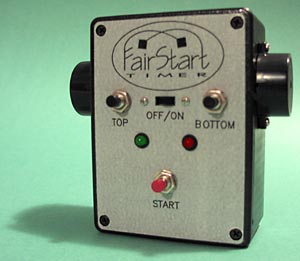 |
In the fall of 2003 I was introduced to the 2003 North American Fighter Kite World Cup Champion, Bruce Lambert. Rick sent Bruce to me (via email) after he had asked for assistance with a project he had in mind. Over the course of several months Bruce and I have become very good e-friends.
Bruce had a vision for a totally radical method of starting North American Line Touch fighter competitions. From our collaboration the 'FairStart' timer was born! Bruce wanted a device that would produce a random sound from a choice of two after a random delay in order to make the start of competitions completely fair to both the fliers and the judges. I spent more than 200 hours designing the electronic circuit and the program on the programmable chip. I had played around with circuits for many years as part of my Ham Radio hobby but this was the first time I had built a circuit completely from the ground up and the first time I had used programmable chips. Needless to say the learning curve was huge. The final device is a great success and is now being used by fighter kite fliers across North America with very positive results. |
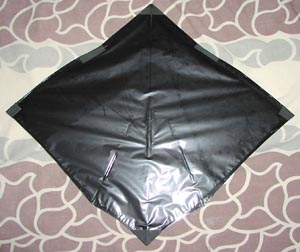
|
My introduction to Bruce opened up a whole new world of kites and I rapidly became hooked on fighter kites and fighter flying. These little suckers are fun to build and great fun to fly and when a group of you are flying them together the fun factor increases exponentially! No wonder the most used phrase among fighter fliers is "Big Grins".
My first foray into fighter building was not very successful as I did not have the correct materials to build good flying ones. Once I got access to bamboo spines, carbon fibre bows and the correct sail materials things changed rapidly. My first fighter with a bamboo spine, carbon bow, and mylar sail was a 'Saucy Owl' and it flew great right out of the bag! I had a lot of fun with this kite flying in deep snow and freezing temperatures until it had an argument with a bare tree and lost! A quick patch up with sticky tape and it was flying again.....gotta love these fighters! |
 |
Next up was a 'Big Guy Indoor', a super light kite that will actually fly indoors with zero wind. The sail material for this one is polypropylene gift wrap as used for wrapping gift baskets.
It is shown here sitting on an 18" pizza box (the perfect size for fighter kites). |
 |
My third fighter was a change of direction as I decided to try a sewn Buka style. The sail is 1/2 oz. ripstop nylon with carbon fibre spars and bow. Bukas fly very differently to 'regular' fighters but are great fun even if they are difficult to relaunch after a crash. |
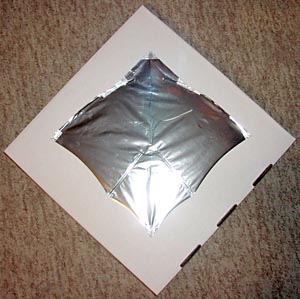
|
It was time to try my hand at designing fighters and this was the result. I call it 'Opus 1' (from my musical background) and I built it in two different sizes.
The silver one has a .05" diameter bow and the blue one has a .06" diameter bow. The sail material for both is polypropylene film. Both kites fly very well and I am pleased with my first fighter design. The plans for the 'Opus 1' are available by following the 'Plans' link on the left. |
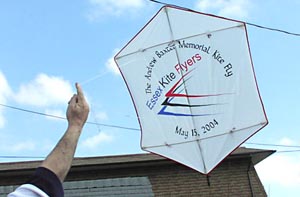 |
It was time for a break from fighters and with the 2004 Make-A-Wish® Fly fast approaching we were asked if we could come up with a 'special' kite for the event.
This Rok is the result and stands just 3 feet tall. The logo is appliqued to the sail and the black lettering is done with a black fabric marker. It took four coats to get the black solid enough when the light is behind the kite. |
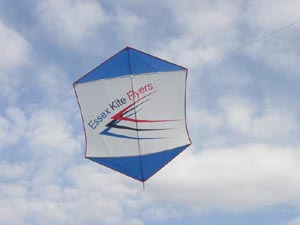 |
Rick was so impressed with the 'special' kite he asked us to build a 'Club' Rok. This stands seven feet tall and again the logo is appliqued to the sail. This is a majestic kite in the air and is a great advertisement for the Club. |
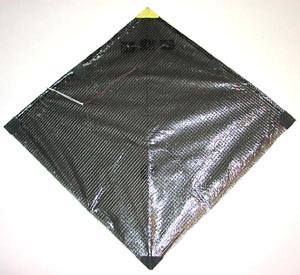 |
After our Club put on a fighter building class Karen got into building fighters too. This was her first attempt at a fighter, built in the class, and it is a 'Dust Devil' with an Orcon sail.
She did a fantastic job of building it and it flew perfectly with very little adjustment to the bridle. |
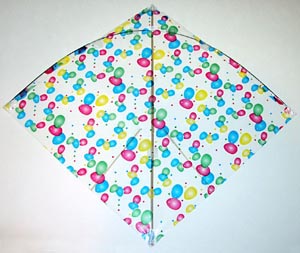 |
The fighter bug has bitten Karen too! This is her second attempt at a fighter, the 'Blade', and the sail is Cellophane gift wrap covered in eggs! It is a beautiful flier and another well built kite...way to go girl! |
 |
This is Karen's third fighter and she chose to build a 'Donna's Dog'. This time she built it with no assistance at all and it is yet another winner! |
 |
I have been busy building fighters again. After flying Karen's 'Blade' I had to have one of my own but I used the blue poly film this time. |
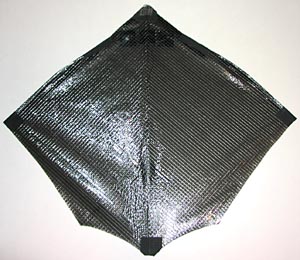 |
Rick has a Terry McPherson kite that he loves but it is showing signs of too much flying so he asked if I could make a template from it so he could build a replacement. I was glad to oblige and built one myself with an Orcon sail. This is an amazing little fighter that tracks straight and true and spins like a top! |
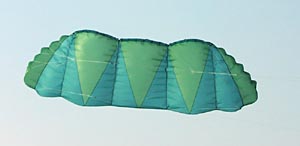 |
Rick asked me to build him a NPW-HA and we built it over the Easter '04 weekend. The size is 5M^2 and it pulls like a truck and yet it is very manoeuvrable. |
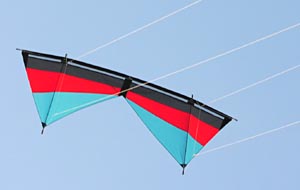 |
Although our Freedom 2000 flew quite well we felt there was room for improvement. We had some lighter sail material and a stiffer cross spar available so we decided to make a new sail for it. The difference was unbelievable and it is a totally different kite now, very fast, super responsive and a pure joy to fly. What a difference those changes made! |
 |
Rick and I had been looking for a 'matched pair' of kites for a long time and decided that the 'Orange' looked like a suitable project. It took several weeks and a number of different bridle configurations before we finally got them tuned the way we like them but they fly very well now. |
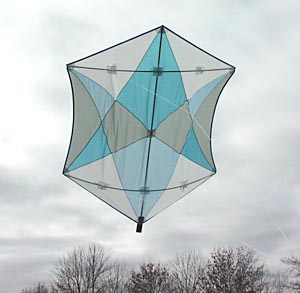 |
Barb Osmon asked us to build her a Rok for a Christmas present to herself. She bought the material but did not want to know what the design was going to be as she wanted a surprise when she opened the package on Christmas morning.
The Rok is 6 ft. tall and turned out very well and flies like a dream. |
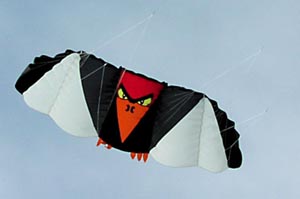 |
After seeing Rick's NPW-HA 'NPW Bill' from Phoenix, AZ asked if we could build him a 'Vulture' HA. We had an unflown 'Vulture' NPW9b and took it apart at the central seams and then added two more central panels and rebridled it. Rick test flew it and proclaimed it to be a much better flier than his own (I guess practice makes perfect.....lol). The kite was shipped to AZ in time to be a surprise Christmas gift for 'NPW Bill'. Needless to say he was 'over the moon' when he opened the package. |



